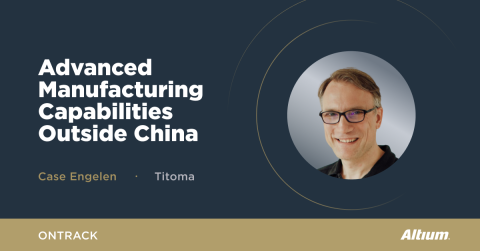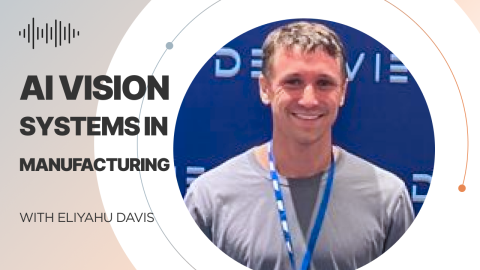Resilient and Secure Domestic Supply Chain

Travis Kelly, President, and CEO of Isola Group returns to continue the conversation on the CHIPS Act.
In this episode, we will focus on North America's and neighboring countries' readiness and technological capability to build a resilient and secure domestic supply chain. We will also briefly discuss some initiatives to attract the young generation and to bring awareness to the “cool” technology behind the PCB industry.
Listen to Podcast:
Download this episode (right-click and save)
Watch the Video:
Show Highlights:
- Zach introduces Travis Kelly
- Right off the bat, Zach, and Travis started the conversation on the CHIPS Act and the growing conversation about diversifying the supply chain
- The support for American-made PCBs is strong and Travis is positive that it will be a top agenda in the congress
- Technological capabilities and the “know-how” are two challenges of onshoring the PCB production
- The allocation of the CHIPS Act fund is still uncertain, Travis shares his forecast and believes that there will be complimentary legislation dedicated to IC substrates
- Loan versus investment. The government's role is to finance efforts to bring technological know-how, support R and D, STEM, the Universities, as well as on-the-job training
- The 25% tax credit to the OEM for every American-made printed circuit board they purchase is a great strategy to promote supply and demand sustainability
- Demand versus interest. One of the challenges the industry has been facing is the workforce shortage. The younger generation is not interested or may be unaware of the opportunities in the PCB industry
- The IC substrates, a more advanced version of a printed circuit board may bring more interest to the younger generation and eventually lead to awareness of the whole PCB ecosystem
- We will soon see more movements on the bills pushing through
Links and Resources:
- Connect with Travis Kelly on LinkedIn
- Visit the Isola Group website
- Watch previous episode with Travis Kelly: The Benefits of Diversifying PCB Industry Supply Chain
- Watch previous related episodes:
- Read related article: Maximum Usage to Improve Supply Chain Resiliency
- Learn Printed Circuit Board Design, Register for FREE
- Connect with Zach on LinkedIn
Get Your First Month of Altium Designer® for FREE
Travis Kelly:
If I were to show you a piece of laminate, it is a paper weight. It could almost look like a coaster. You would have no idea the importance of that laminate. So what we've done is instead of talking about laminate and talking about the different types and the different characteristics, we talk about the end uses. When we start telling them that it goes into aerospace applications, it goes into defense applications and medical, and really get down into the weeds on exactly what programs it's in and what systems, that's generating excitement.
Zach Peterson:
Hello everyone, and welcome to the Altium OnTrack Podcast. I'm your host, Zach Peterson, and today we're talking with Travis Kelly, CEO of Isola Group and chairman of the Printed Circuit Board Association of America. Over the past year, there's been quite a bit of legislation supporting the electronics industry, and the PCBAA has been one of the organizations at the forefront of that. And of course, we're always happy to talk to Travis Kelly. Travis, thank you so much for joining us again.
Travis Kelly:
Yeah, thanks for having me, Zach, and happy New Year.
Zach Peterson:
Happy New Year to you too. Yeah, man, the holidays were crazy this year.
Travis Kelly:
Yeah, they were. It's a nice break, however, there's so much happening in the world, it's hard to enjoy it, right? I mean, obviously with not only the geopolitical issues but obviously the macroeconomics that are impacting the global marketplace. It's definitely been busy. I think people, when COVID first came out, they always thought the next year would be better, and I think going into 2023, obviously there's going to be a lot of opportunity, but there will continue to be challenges.
Zach Peterson:
Yeah, ever since 2020 it's always been, "Next year will be better. Next year will be better."
Travis Kelly:
We're still waiting.
Zach Peterson:
Hopefully third time's a charm, right?
Travis Kelly:
Yeah, that's right.
Zach Peterson:
Yeah. So I mean, you brought up micro macroeconomic developments and then geopolitical developments. I mean, there's been a lot going on lately since we last talked. When we had previously talked, I think that was right around the time H.R.7677 was introduced in the US House, and the CHIPS Act was passed, I believe, shortly after that. And there's been a lot going on in the industry, and the conversation around these issues has shifted a little bit in terms of the focus from just semiconductors. And for those of us in the industry, it seemed to shift more towards the entire supply chain and now advanced packaging as well. So what have you been seeing in the industry regarding these issues?
Travis Kelly:
Yeah, you're spot on, Zach. I mean, I think part of it, obviously, we being the Printed Circuit Board Association of America is 100% supportive of the CHIPS Act. And I think as people became more conversant on the ecosystem itself, a lot of people, and people would be both private and public industry, government, came to the realization that it's much broader than the wafers. It's much broader than just semiconductors, right? You and I spoke before saying that definitely addresses a symptom of the overall problem, but it's not the root cause. The root cause is really looking at the ecosystem. So your printed circuit boards, not only fabricators but assemblers, the advanced material science companies like Isola and our competition, and what is needed to create that resilient domestic supply chain. So you've really seen the discussion evolve from just semiconductors to now what are we going to do as it relates to advanced packaging? Do we really want the wafers to go overseas for packaging and then back into the US for the ones that are destined for the US?
How can we build up that infrastructure domestically so we can do the packaging or the IC substrates here in-house here domestically? So that conversation has really resonated I think with government, definitely has resonated too with the private industry as companies look at how can they solve this problem, right? We spend a lot of time trying to understand and define the problem statement. And I think as the industry gets its voice around it, which I think believe we have, the government's listening, because we've only addressed a symptom. We haven't addressed the root cause. So I do believe there'll be continued momentum. Obviously we need a Speaker in the House to start pushing legislation through and policy, so we have to get what's happening in Washington behind us so we can actually get some consequential things done, because I think there's still a lot more to do. There's still a heavy lift to ensure that we have a resilient and secure domestic supply chain as it relates to micro electronics.
Zach Peterson:
And it's not just PCBAA that's involved in this, it's groups like IPC and I believe even SMTA is getting involved. There seems to be a broad coalition of industry groups that are really behind this effort to geographically diversify the supply chain and then bring some of that closer to home. And then there's also a European version of the CHIPS Act, so I mean this really seems to be a worldwide phenomenon. It's not just something that's just for the US.
Travis Kelly:
Yeah, that's exactly right. The PCBAA, many of our members are members of IPC as well as USPAE, and we work very close together to push the important initiatives across the finish line, and I think that's where you're seeing a lot of momentum, because ultimately we're all trying to do the same thing, and that's ensuring that we have continuity as it relates to electronics. And it's not meant to be a myopic view where we're saying everything has to be in the United States of America. What we're saying is identify those critical end segments where you do want to have a resilient supply chain, and then what makes sense as we will always live in a global marketplace, but where do we want to have that ecosystem reside? So it can be allied countries, it can be obviously North America in general, so Canada and Mexico, and I think you're seeing IPC, USPAE, PCBAA, and obviously the EIPC in Europe all working hand in hand and delivering the same message. And a lot of that too was the catalyst behind COVID.
Micro electronics is what I'm focused on and what our organization's focused on, and the discussions are happening with pharmaceuticals, the discussions are happening in segments where you don't have a resilient domestic supply chain. It's a resonating story because people have seen what happens when you have a disruption and a disruption can be a pandemic, it can be a ship getting stuck in the Suez Canal for several weeks that halts international production. Dell has made comments that they're moving their production. Obviously the issues that we've seen in Asia with the COVID-19 outbreak. So you just take all of this information, and once again, you have to understand and you have to identify what are those critical end segments that you want to have protected and have a resilient supply chain for because you can't afford to go without certain things for long periods of time.
Zach Peterson:
Now, listeners and viewers of the show will know that we actually talked to Representative Blake Moore last year, and I was encouraged that he was so enthusiastic about all of this, but he's just one person. So my question to you, because you're closer to this than I am, try as I might to talk to some of these folks sometimes, I'm wondering how receptive are people in government to these initiatives, because you have to have that backing from the government? And is that same type of enthusiasm in the government sector seen in Canada, Mexico, over in Europe? What would you say to that?
Travis Kelly:
Yeah, I think the enthusiasm and the support is still there. The interesting thing about H.R.7677, which is supporting American made PCBs, and by the way, obviously with the new Congress, when it's sworn in, that codification will change, so the number will change and we'll find out what that will be. But the interesting part about that piece of legislation is the fact that it's bipartisan, so it's not just Blake Moore, the Republican in Utah, it's also Anna Ishu, the Democrat in California. So that gives us a lot of comfort that it is a bipartisan bill. Obviously we still need to garner sponsors across both ends of the island, that's something that the PCBAA will be doing in 2023, and then we also need a companion Senate bill as well. However, first and foremost, obviously the Speaker needs to be elected so we can move forward with some of this important and consequential legislation. But I still truly believe that that will be at the top of the agenda for many of the people I just mentioned.
We're also, me in particular, I have been reached out to by several very similar organizations, to your point, in Europe, asking, "Hey, how have you created such momentum in a short period of time? Do you think we could partner in Europe and have the same message?" Now Europe's a little bit more difficult. Obviously in the US it's one central government. Obviously in Europe there's numerous governments, so that's going to take a more strategic approach in how do you actually start effectuating change when you have so many different constituents in so many different countries? But the point being that people across the globe are recognizing the momentum we have. I think as we continue to move through 2023, unfortunately there's still going to be disruptions in the supply chain. We're already seeing that. I think that momentum is not going to go away.
I think what will ultimately happen is, once again, we will have to get our voice, our voice being obviously the United States, North America, and allied countries around what are those important segments that we want to make sure that we have that supply chain for the domestic and resilient supply chain. And that's really going to be, I think, the focus of 2023 as well. And those meetings are happening. There's different meetings happening right now in Washington where those conversations are happening, especially as it relates to IC substrates too. Obviously printed circuit boards is a very large discussion. Chips have to be embedded on something. We always say chips don't float. You can produce all the chips you want, but unless you have a printed circuit board to embed it into, it doesn't work. And vice versa, a board doesn't work without a chip. So this is resonating, the support's there, and it will continue to be there.
Zach Peterson:
The central argument that it is, I guess, convincing people related to, let's say, the ability to just buy stuff at the consumer level, is it a national security argument, is it more holistic? What part of this argument about we should be supporting a robust supply chain locally, which part of that argument is maybe the most convincing for folks?
Travis Kelly:
Well, I think it depends on who the audience is. I think when you're in Washington, obviously the focus is going to be on defense, to your point, and ensuring that you can scale up, you being the domestic industry, can you scale up if everything needs to be produced in North America? Is the capability there? And not only the capability in terms of volume production, but does the technology exist to get to what you need for certain end use applications in defense, right? So a lot of that technology right now exists overseas. So it's not just bringing back the volume, which is machines and equipment, it's also bringing back that technological know-how. So I think ultimately that will continue to be a focus. It has to be a focus. There's numerous meetings happening right now to ensure that technology exists. And then, as you and I discussed before, when you ship production capabilities overseas, you're also shipping that technological know-how, and those skill sets that are needed also are shipped over.
And what we need to do, once again, is focus on the educational system in STEM as well as on the job learning. I've mentioned before signal integrity engineers and this certain DNA you need in people to make sure that this industry is successful, that has to be a big focus as well.
Zach Peterson:
Well, you brought up a couple points here, and I want to look a bit closer at the implementation of the CHIPS Act, because there is a panel, I guess, through National Institute of Standards and Technology composed of folks from industry that is providing recommendations for how some of this funding from the CHIPS Act should be implemented. And I think that was where the conversation really shifted towards advanced packaging. And then folks who are familiar with IC substrates and packaging will know that IC substrates are basically just a really high density circuit board. There's very little difference, especially when you look at the cross section of one of these systems. So I mean, will that conversation by them ever shift to the point where, "Hey, some of this money should also go to PCBs." Do you see that as possibly a hedge against maybe the Printed Circuit Boards Act failing in Congress or in the Senate?
Travis Kelly:
You're spot on, right? The high density interconnects is a very complex printed circuit board. We call it IC substrate, but you're spot on. I don't think that they're going to be conflicting pieces of legislation. I think they're going to be complimentary, because we do have to define what is a semiconductor, what is IC substrate, what is a PCB? So I don't see that getting merged under one, because, although similar, they are different and unique. So the way I see it rolling out is the $52 million CHIPS Act, a lot of that will be actually for the wafers. You're absolutely right, some of it is being discussed like, "Hey, what are we going to do with the IC substrates?" There won't be enough there obviously, to support the entire ecosystem. So I view the supporting Printed Circuit Boards Act of America as complimentary to that. And it's not a silver bullet. This is an iterative process.
When you think about the capital investment that will be needed to build up the domestic PCB industry to support the type of technology, like you said, the high density interconnects, it's going to be very difficult for printed circuit board fabricators, assemblers, and the material suppliers to justify tens and tens of millions of dollars or hundreds of millions of dollars and new facilities without really understanding what that demand signal will be, right? Everything requires an investment thesis. Most of these companies have some type of board for governance. So when you go and ask to spend capital and dollars, you need to understand is there a payback? And right now there's very little clarity in Washington and even in the private industry saying if you build it, they will come. I don't think there's going to be too many CEOs that are going to take a risk of building 150 or $200 million brand new facility to, once again, do high density in interconnects without knowing that the volume's going to be there. So how do you solve that problem?
One way you solve the problem is working with government to figure out, okay, if all of defense is only roughly 4% of the overall market share, that's not enough to have one of these companies or several of these companies put that type of money into a capital investment. So what we have to do is look at aggregated demand. And once again, I keep going back to this, if we decide that there are certain end segments that we want to protect, and protect can mean just having a resilient supply chain, so infrastructure banking, obviously medical, aerospace and defense, if we decide there's five or six key industry segments that we want to have a resilient supply chain for, if you had an aggregated demand signal, that is roughly 26% of the overall global market share. I think you could see a lot of domestic CEOs and companies justifying that investment thesis, going to their boards of directors saying, "Look, we're going to go and spend," I'm making the number up, "$200 million because we believe that this is enough market share that we'll have a return on that investment."
And that's going to take not only the private industry and CEOs like myself to come to the table, it's also going to take the government to make sure that we can say these certain industries need to be protected. So that that's really where the rub is, right? It's easy to talk about this stuff at a theoretical level, but when you have to start spending money and you have to continue to produce enough cash flow generation to support the business, then you really have to get down into the weeds and say, okay, what exactly are we talking about? How much volume is there? Because these are big investments, right? That's just brick and mortar, the 200 million. That's not the investment that it's going to take in the workforce. That's not the investment that it's going to take in the overall ecosystem that's going to have to actually supply those different facilities. So you can see that trickle down effect. It's great for the overall economy. It's great for innovation, because to stay competitive in a global marketplace is going to require a lot of automation.
When people hear that term, they think, "Oh, well that just means you're not going to have as many workers." You're going to have a lot of workers at a higher skillset. It actually helps the economy because you're going to look for the controls engineers, the mechanical engineers, the electrical engineers, the signal integrity engineers, and all of a sudden your workforce globally, or definitely domestically, expands. I mean, there's a lot of positive things there.
Zach Peterson:
When you look at the numbers from semiconductor companies in terms of their investment outside of Asia, the numbers are ridiculous. I think Samsung's investment was like a $100 billion, so double the CHIPS Act. Micron, Intel, I mean you start adding it up. I mean, you're talking a significant fraction of a trillion dollars that these companies are investing in production capacity, and the CHIPS Act ends up being a small portion of the overall investment. So I guess when you look at it from that perspective, it doesn't seem like that much is needed from government to really kick this off. So that brings up the question, in H.R.7677, are the numbers that are in there the objectively right number, or is that really too expensive for folks in government to try and justify, or do they not even care about the number, there's some political reasons for why they might want to pass a bill like this?
Travis Kelly:
Yeah, I mean I would hope and I would expect that they care about the number. The number right now in that current bill is roughly $3 billion, which to your point is it's still significant because it's real money, but nothing like what you see in different industries and in other countries that actually support their internal industries and the amount of money that they invest, especially in some countries in Asia, where they'll put in hundreds and hundreds and hundreds of billions of dollars to support and prop up industries. The key is, and the word you used, which resonates, and it's an important word, is an investment, right? It's not a loan. It's an investment in an industry, and I think that's where the government really has a role to play. I think if you can prop up an industry, let's say it's three billion dollars and that gets you some brick and mortar so you can scale up, it gets you some technological know-how, R and D investment, some STEM backing and university, as well as on the job training.
That's an investment in an industry that can definitely grow and be competitive on a global scale. Now, that's the first part. If you bifurcate that, what's the sustainability part, right? And sustainability meaning how do you keep the industry growing? How do you make it self-sufficient? Because the government, it can't be treated as a bank. It can't continue to throw money at problems. So what you're really asking for is give us the initial investment to at least prop it up and give us direction on what we need to do, then the industry has to work together with the government for that aggregated demand signal so it's a sustainable industry. Because it can't just be the government loaning out money or granting money every single year, and that's why I think H.R.7677 is so important. I like the fact that it's a poll strategy, because not just the original investment from the government, but as you and I discussed last time, it's also that tax credit.
Now, I don't know if that bill will change as we go into the new Congress, but ultimately it was a 25% tax credit to the OEM for every American made printed circuit board they purchase. That creates a pull demand that I'm asking for, right? So ultimately you have the three billion dollar investment, get the brick and mortar, build up the industry, but then to make it sustainable, giving the 25% tax credit's extremely important. And then ultimately creating the different demand signals on industries we think are important should be and will be sufficient for companies to operate and generate enough cash flow where it can be a self-sustaining industry and competitive on a global scale, because I think one thing this will allow us to do is, once again, look at the factories of the future, the automation, the way you can be competitive against countries that may have a lower cost of labor.
Zach Peterson:
So I want to shift gears for just a moment, because you've brought up a couple of times workforce issues, or at least you've alluded to them, and in talking to other folks about these issues, workforce has come up several times, not just from folks in industry but also IPC and then some other groups in the industry. So yesterday I was actually talking to a couple people from Printed Circuit Engineering Association, and their entire mission is providing educational resources as part of workforce development. So one of the things with workforce development that is important to, I think, recognize is that you can throw all the money that you want at educational programs to create that material and just essentially create these programs at colleges and universities, but the problem is that if the students and kids don't recognize the importance of these, then you're going to have low attendance, and when you have low attendance, especially at the university level, suddenly they become candidates for getting slashed. So I think we have to ask the question what can we all do to get kids interested in electronics again?
Travis Kelly:
Yeah, that's a great question Zach. The technology that we're in is not really viewed as technology, right? It's not the sexy part of technology. I'll be honest, I don't know if I can say this, but I tell my three young kids that my work is technology's ugly cousin, because what we are is a manufacturing company. Now, I'm speaking on Isola. And we're having a hard time, to your point, generating excitement around, "Hey, come work for Isola. It's a technology company." I know that some of my customers are printed circuit board fabricators are having a similar issue. To your point, what we've done and that has been resonating, and we've been invited to numerous really prestigious universities, not only at their employment fairs, but also giving discussions to, I'll say, their engineering schools is talking about the end use of our products. So if I were to show you a piece of laminate, it is a paper weight. And I know you know what laminate is, but it's basically copper, glass, and resin pressed together. It could almost look like a coaster. You would have no idea the importance of that laminate.
So what we've done is instead of talking about laminate and talking about the different types and the different characteristics, we talk about the end uses. We find people don't get overly excited about laminate, but when we start telling them that it goes into aerospace applications, it goes into defense applications and medical, and really get down into the weeds on exactly what programs it's in and what systems, that's generating excitement. And I think we as an industry can do a much better job, because if you go in and you show... We have these great little cards here, Printed Circuit Board Association of America. This is an actual working printed circuit board, which is very interesting. If you were to show this to a lot of university students, they would probably prefer to go into artificial intelligence or drone building, things like that, but when you show them that this can go into numerous applications where it's rocket boosters, satellites that get launched, and all the other applications, it becomes very exciting. And that's what we as an industry need to start teaching and advocating for.
And I think with that you will see an increase in the participation levels at a lower age, especially at the university level, because that's when really you have to go get the employees and create that spark. We do a lot of work now with internship programs. Luckily because we're a global company, we're by some of the most prestigious universities and we're able to go in now into their engineering departments and discuss what we do, how we do it, and the impacts on daily life. And that's why I think we've really in the last couple years have seen an increase in the amount of interns we get and the amount of job applications we get when these young engineers are graduating from university.
Zach Peterson:
Does the IC substrate packaging tangent from printed circuit board materials also excite students to get into hardware at some level? Because, as we mentioned, essentially IC substrate's a more advanced version of a printed circuit board. And I think at this point everyone has become familiar with semiconductors again, so I'm wondering if students are now shifting their focus to, "Hey, semiconductors are really important. I want to be there." But then getting them to understand the importance of printed circuit boards, laminate materials, things like this, if the IC substrate and packaging discussion is also valuable for getting students into the industry.
Travis Kelly:
Yeah, you're beginning to see that. You're actually beginning to see some universities even offer that. And I think students will find that intriguing, because the amount of technology that will be needed not only for high density interconnects, which will obviously lead into printed circuit boards, I think will be appealing to a lot of really young and smart people. And I think, once again, as you go back into the terminology of an ecosystem, I think that's where you're going to see universities say, "Hey, there's a problem statement here. There's a problem to be fixed." That problem could be the substrates and the education that's needed. It could be signal integrity engineers. I think we're going to see some growth in that as well, so we don't have to file H-1B visas to get other people that have that knowledge into the country, which is more difficult to do every year.
So I think you're going to see a growth, but once again, similar to what business people, CEOs, companies need to see with that investment thesis, a young student that's picking their university and their major, they want to make sure that there's a demand signal for them coming out of a school, right? So my point being that we have to... I use a term a lot saying everything relates to everything, and that's part of it. I heard that from someone that took me under their wing for many, many years, and it's absolutely true. So we can talk about aggregated demand signals, we can talk about substrates, but everything does relate to everything, and not only do I need to see a business case to justify a $100 million spend, that student that's picking their university to start next year and what program they're going to major in I would assume wants to make sure that they have job opportunities when they graduate.
And right now, I think the substrate and PCBs in its infancy is getting momentum, but I think as we fast forward in a year, maybe 18 months, you're going to see more and more about it. Plus it's manufacturing, and I think that's fascinating. Obviously been in manufacturing a long time. And service industries are great too, but I think here's an industry where it's manufacturing, it's technology, it's cutting edge, and you're going into some of the most important end products that are known to man. I mean, be it space shuttles. I mean, if you think about all the different micro electronics that's required even in your vehicle now. Not only do you have radar systems looking for adaptive cruise control and looking out, you also have them looking in. There's sensors that we're with customers that will determine if there's a baby in the back seat just by breath rate and heart rate. It's fascinating. So I think that's what we find is intriguing for those students, not showing a piece of laminate saying, "Hey, do you want to come work for Isola and build this laminate?"
Once again, I'm sure that printed circuit board fabricators and assemblers are doing the same thing, right? What are they doing to intrigue that talent?
Zach Peterson:
Well, I think that's extremely insightful, and I think sometimes us as folks who push the educational message, we get a little too into the weeds and we do exactly what you said, which is focus on the laminate, not focus on the end application that it enables.
Travis Kelly:
That's right. Yeah.
Zach Peterson:
Well, we're getting up on-
Travis Kelly:
I think that's important, right? They always say sell the features not the actual product, and I think that you can use that interchangeably for recruiting top talent as well.
Zach Peterson:
Absolutely. Well, we're getting up on time, so I want to thank you so much for taking time out of your busy schedule to join us and talk about these important issues, and we'll be happy to have you on again in the future.
Travis Kelly:
Yeah, I appreciate it, Zach. I think it's going to be an interesting year. I think, once again, Congress needs to get a speaker so we can actually start pushing through some of these bills, which are consequential to what we're trying to accomplish. But I appreciate it. This is a great platform to get our voice out there, and look forward to seeing you again soon.
Zach Peterson:
Absolutely. You too. Travis, thanks for joining us. To everybody that's out there listening, we've been talking with Travis Kelly, CEO of Isola Group and chairman of the Printed Circuit Board Association of America. Make sure, if you're listening or watching on YouTube, to hit the subscribe button, and you'll be able to keep up with all of our episodes as they come out, as well as tutorials. Thanks again, Travis, and to everybody that's listening. Don't stop learning, stay on track, and we'll see you next time.










